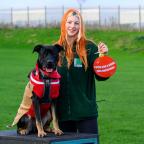
Essential tips for taking your dog on a summer staycation
It's National Pet Travel Safety Day - experts at tails.com have shared they handy guide to staying safe!
There's no doubt about it, 2021 is the year for staycations. And many of us will be taking our four-legged friend with us as we head off to UK resorts for a much-needed summer break.
It's a well-known fact that we Brits love our pets, and we like to involve them in everything - including our holidays. In fact, a new study has revealed that a staggering 69% of the UK would rather go on a staycation with their family pet than their other half.
But before you and your furry friend head off on your rural rambles, it's wise to do a little preparation to make sure you have the paw-fect break. With this in mind, we've asked the team at tails.com to share their handy travel guide to staycationing with your pooch.
The full content is available below or in a Google Document format on request.
Essential tips for taking your dog on a summer staycation
Make sure you pack the essentials
When you've got four more legs joining the journey, there are a few essentials to keep in mind when planning your next staycation. Remember to pack a plentiful supply of your dog's favourite food. Dry kibble dog food is perfect if you're camping or staying somewhere without a fridge. Keep a bottle of fresh water in your bag and a portable bowl, just in case.
Don't forget to take plenty of their favourite treats and toys, especially if you're planning on visiting a dog-friendly pub and need to keep them entertained. For a beach holiday, check to see if your toys float! British summers can be incredibly warm, but they can also be incredibly wet, too. Pack for all eventualities with a raincoat and cooling jacket to keep your pooch comfortable whatever the weather.
Pack plenty of fluffy towels (for sandy or wet fur), comfortable blankets (to make them feel safe and warm), and take their bed so they feel at home. Keep poop bags attached to the lead so you have them with you, wherever you go. Bring along a tether and long lead, to keep your dog safe if you are camping or visiting the beach.
Dogs generally get exposed to ticks when out and about exploring woodland and high grass. Ticks hide in low shrubs or glass, generally 18 to 24 inches off the ground, and when our canine companions walk by and brush up against these, the ticks dislodge. Before heading on your journey, remember to pack a tick remover tool.
Stay prepared with dog-friendly apps
While travelling with a canine companion is a bit different and sometimes more challenging than travelling solo, there are some handy apps out there that can make the experience easier. BringFido is an excellent app for quickly locating dog-friendly destinations, accommodations, pup-approved restaurants, beaches and, of course, parks.
Dog owners share their experiences and reviews along the way, which makes tailoring your trip to your pooch's needs that much easier. Plus, the app has easy to use filters for those travelling with larger dogs or multiple pets in tow.
Track your dog's location and activity with the Tractive app. Just add the GPS to your dog's collar and trace his exact movements. The app will automatically alert you should your dog leave its safe zone. Add a tag to your dog's collar with your staycation location or a phone number so that you can be contacted if your pooch goes walkabouts.
Take your staycation to the next level with the app, All Trails, which helps you sniff out the closest dog-friendly walking trails in the area. The app also tells you how long it will take to complete the trek, the distance, visitor star rating and a map to assist you on your journey.
Travel safely and comfortably
Wherever you may travel, be sure to take proper safety precautions. If you're planning on travelling by car, you'll need to take some steps to prepare your dog's needs along the way.
For the protection of your pet and other passengers in the car, your dog needs to be restrained during the ride. You can safely do this with a seat belt harness, pet carrier, dog cage or dog guard, this will prevent your dog from moving around while you drive.
Motion sickness in dogs is a common problem. To prevent any upset stomachs on the journey feed your pet a light meal three to four hours before you embark on your adventure. While driving, on a coach or bus, always stop off for a resting period to feed your dog, and never feed them while the vehicle is moving, as this will cause car sickness.
Both you and your canine companion will appreciate a toilet break, a drink of water and the chance to stretch your legs, so plan your resting points ahead of time.
It might look like great fun for your pooch, and it probably is, but letting your dog stick its head out of the window while you drive is dangerous, as they could get an eye irritation or, worse, get injured by something as you drive past.
Preparing your dog for long car journeys is easy if you plan in advance. Taking several short trips with your dog in the car will gradually increase their confidence in the car, making them more comfortable and less stressed.
Be cautious of staycation dangers
When out and about exploring new and exciting places, always take precautions to keep your four-legged friend safe. Although the smells or a different city may seem exciting for your puppy, new environments often pose new threats to your dog.
Exploring a city can expose your dog to dangers that can harm them, from hot pavements to bacteria carried in bird poop droppings to garbage on the street. During the summer months, the pavements in city centres can cause damage to your dog's paw pads, so always test if the pavement is too hot to hold your hand on, or walk on the shady side of the street.
When it comes to exploring the countryside, there are a few hazards that are worth keeping an eye out for, especially when the weather starts to heat up. As you head out onto a walk you may encounter horses, sheep, cows or even other dogs. So to protect your dog and other animals it's important to keep your dog on its lead until safe to remove.
Exploring the countryside with your dog is a great way to stretch your legs and get some fresh air, but it's important to identify the potential poisonous and deadly plants. For example, dogs should not eat berries on the ground, wild fruit such as apples and apricots, chestnuts, rhubarb or cherries found when out exploring.
Taking your dog to the beach? The very things that make the beach so pleasant, the water, sun and sand, could also prove very harmful for your dog. Prevent your dog from overheating by avoiding the beach at the hottest parts of the day and provide your dog with access to shade. Don't let your dog drink the salty seawater, as it can cause dehydration, instead bring along a portable dish with water to keep your dog hydrated and cool.
Protect your dog's health and safety
One of the biggest areas of concern for pet owners when holidaying with their dogs is that of their health and safety. A trip to a new city can expose your pet to harm, so protect your four-legged friend by making a note of the contact details for a local vet, just in case you need them whilst you're away from home.
Bring a first aid kit, many of the items in a human first aid kit cross over with a pet first aid kit. Sensitive sun cream and tweezers are also great to include. Many dog-friendly Airbnb's now include temporary ID tags to attach to your dog's collar when you're away, in case they get lost. If not, it could be worth including your mobile phone number on your usual tag, so you can be contacted straight away







